Key takeaways:
- Artist collaborations enhance creativity, community, and broaden audiences, enriching both artists and their work.
- Clear communication and shared goals are vital for overcoming challenges in collaborative projects.
- Finding the right partners involves aligning artistic values and networking within artistic communities.
- Documenting the collaborative process through journals and photography can provide insights and deepen audience connections.
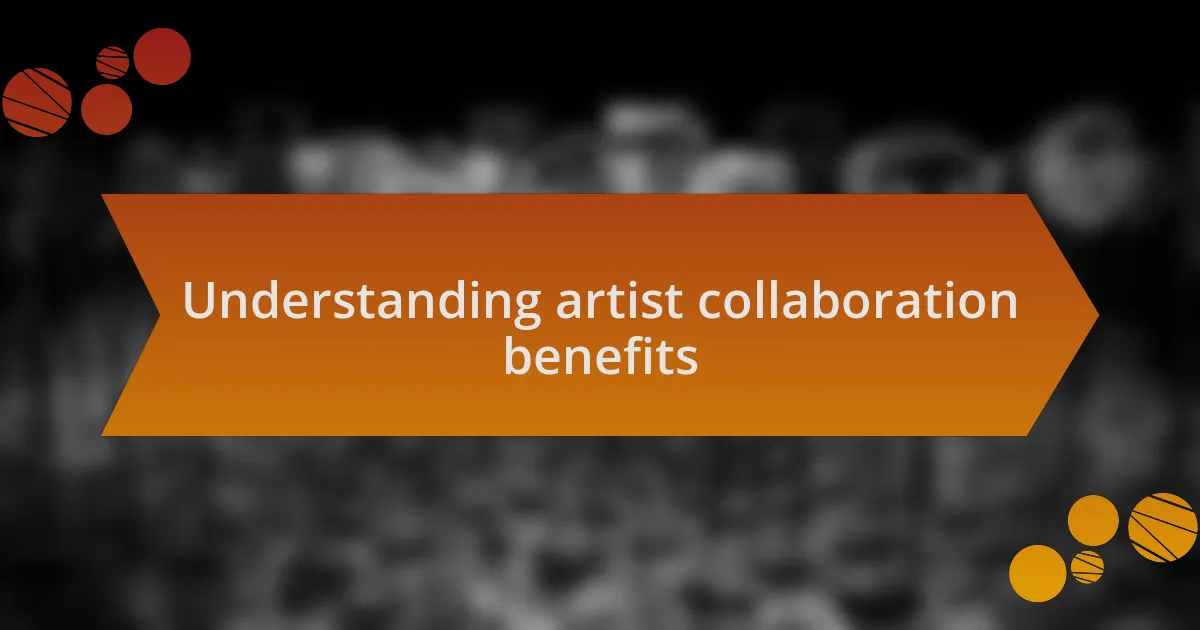
Understanding artist collaboration benefits
Collaborating with other artists can open up new avenues for creativity and inspiration. I still remember my first joint project; it felt like our ideas were amplifying each other, enhancing not just the artwork but also my understanding of different techniques. Have you ever noticed how a simple brainstorming session can lead to surprising and powerful concepts?
The emotional benefits of collaboration are equally profound. When I work with others, I often feel an exhilarating sense of community. It’s comforting to know you’re not alone in your artistic journey; sharing challenges and joys can foster deeper connections and motivate you to push your creative boundaries. Can you recall a time when a partnership helped you overcome a creative block?
Moreover, collaborations can also broaden your audience. I experienced this firsthand when I teamed up with a photographer; his network introduced my art to people I wouldn’t have reached otherwise. Isn’t it fascinating how art can transcend barriers when we join forces, allowing our work to speak to more people? Every collaborative project has the potential to showcase a unique blend of styles and perspectives, enriching both the artists and the audience alike.
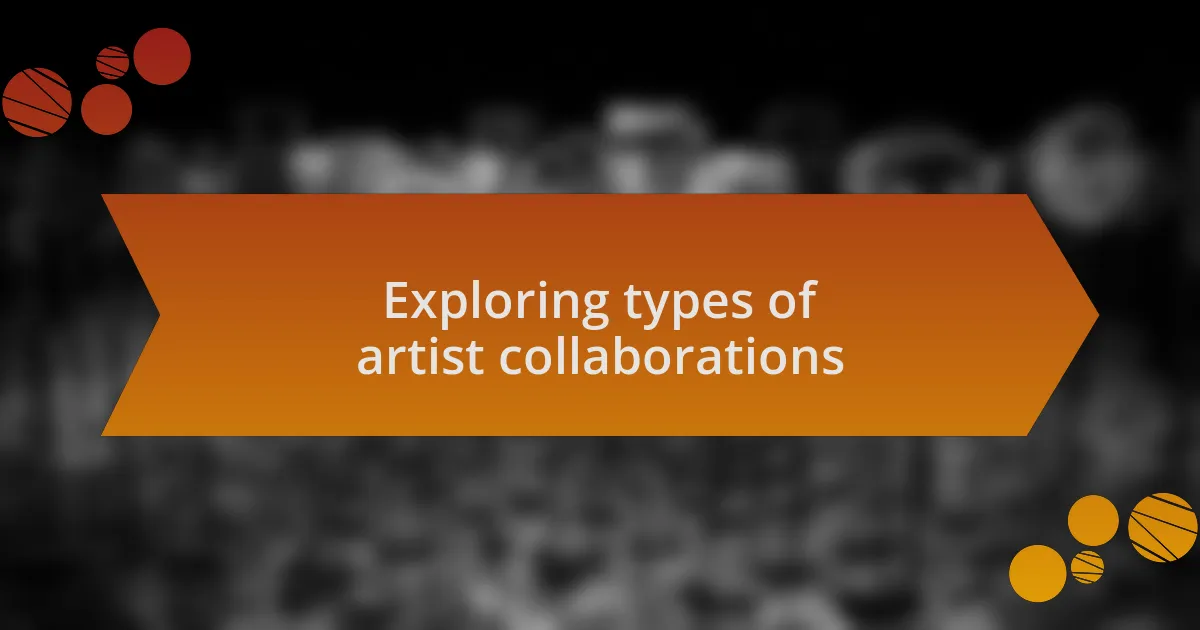
Exploring types of artist collaborations
When it comes to artist collaborations, there are various formats one might explore. For instance, I’ve found that joint exhibitions can yield a powerful showcase of contrasting styles in a single space, creating a dialogue between the artworks. Have you ever walked into a gallery and felt the tension or harmony of differing artistic voices all at once? It’s that dynamic interplay that often sparks deep conversations among viewers.
Another type of collaboration that has challenged my creativity is the cross-disciplinary project. Working alongside musicians or writers, for example, can lead to artwork that tells a story beyond the visual. I vividly recall a time I teamed up with a poet; together, we created visual art pieces that mirrored his verses. The resulting combination was richer and more profound than anything I could have produced alone. Isn’t it intriguing how words and images can enhance and illuminate each other’s meanings?
Lastly, I’ve dived into collaborative art where multiple artists contribute to a mural or large installation. The rush of painting alongside others, each person’s style weaving into the overall artwork, creates a palpable energy. I still feel exhilarated thinking back to a community mural I helped paint, where each stroke became a testament to collective creativity. How do you think such large-scale collaborations influence the art itself and the feelings of those who participate? They often transform simple ideas into a tapestry of shared experience and connection.
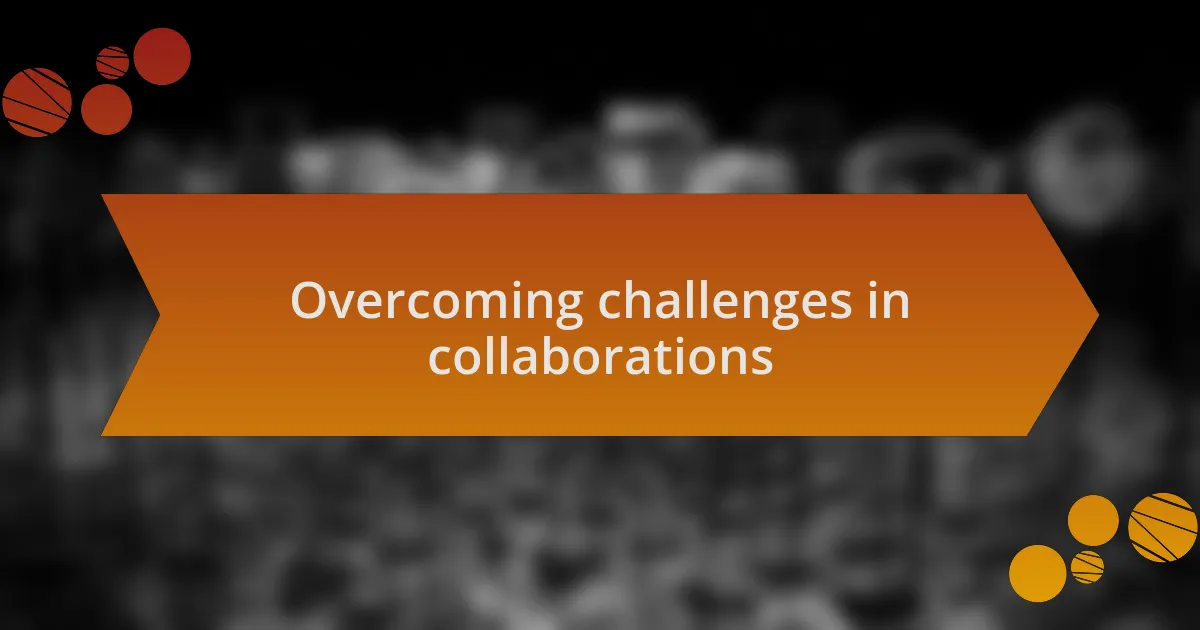
Overcoming challenges in collaborations
Navigating the complexities of artist collaborations can be tricky, as differing visions or styles sometimes collide. I remember working on a project where my partner and I had strong but opposing creative ideas. Initially, it felt frustrating, like we were speaking different languages. But by setting aside our egos and focusing on a shared goal, we found common ground that ultimately enriched the work. How do you approach disagreements in collaborative settings?
Communication is key to overcoming challenges in these partnerships. I learned the value of open dialogue during a recent collaboration where we established regular check-ins to discuss our progress and concerns. This practice transformed our potential friction into productive sessions filled with laughter and creative breakthroughs. Have you ever considered how honest conversations can reshape a project’s trajectory?
Another significant challenge in collaborations is balancing contributions from all involved. I faced this when I collaborated on a piece with several artists who each had their strengths and weaknesses. By actively listening and encouraging everyone to share their ideas, we fostered an inclusive environment that allowed each artist to shine. Isn’t it amazing how this synergy can elevate a project beyond what any individual could achieve alone?
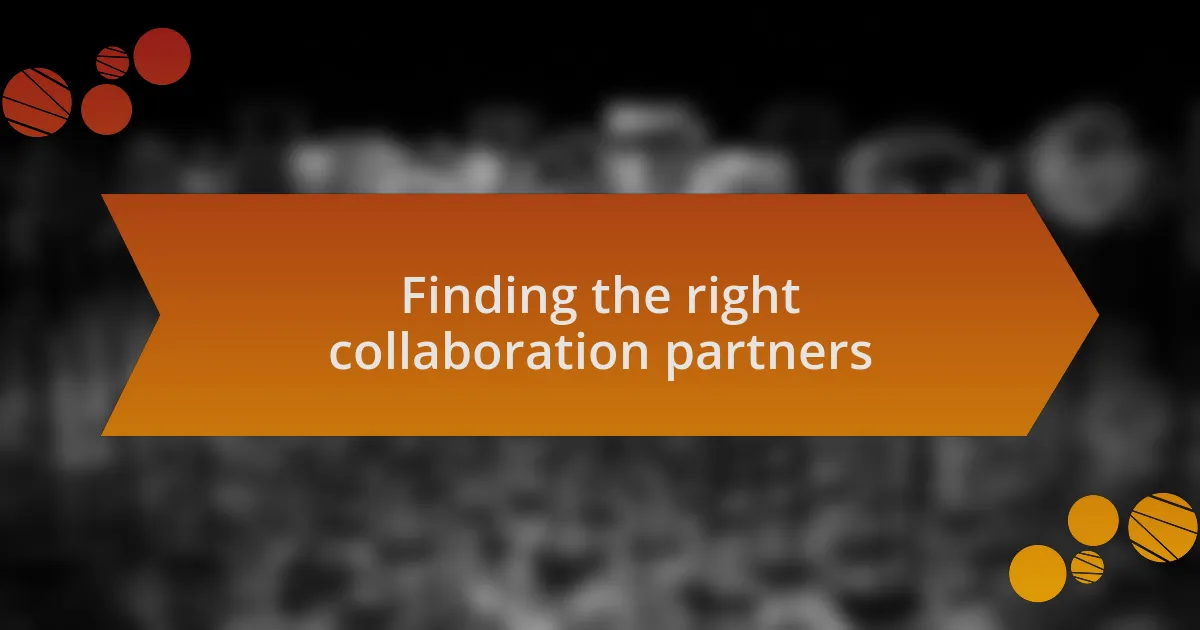
Finding the right collaboration partners
Finding the right collaboration partners is crucial for any artistic endeavor. I remember the excitement I felt when I discovered a fellow artist whose work resonated deeply with mine. We even shared a similar philosophy on art! That initial connection was invaluable, setting a solid foundation for our collaboration. How do you identify those who truly align with your artistic vision?
It’s essential to look beyond just artistic style when selecting collaborators. I once overlooked this aspect, partnering with someone who was technically skilled but didn’t share my passion for storytelling. The resulting piece felt hollow, lacking the emotional depth I strive for in my work. Have you ever considered how shared values can enhance not just the final product, but also the collaborative experience itself?
Networking within artistic communities can also reveal potential partners you might not have considered. I often attend art shows and workshops, and some of my best collaborations grew from spontaneous connections made in those settings. Engaging in social interactions often leads to discovering artists whose abilities and aspirations complement yours. Isn’t it interesting how a casual conversation can open doors to creative synergies you hadn’t previously imagined?
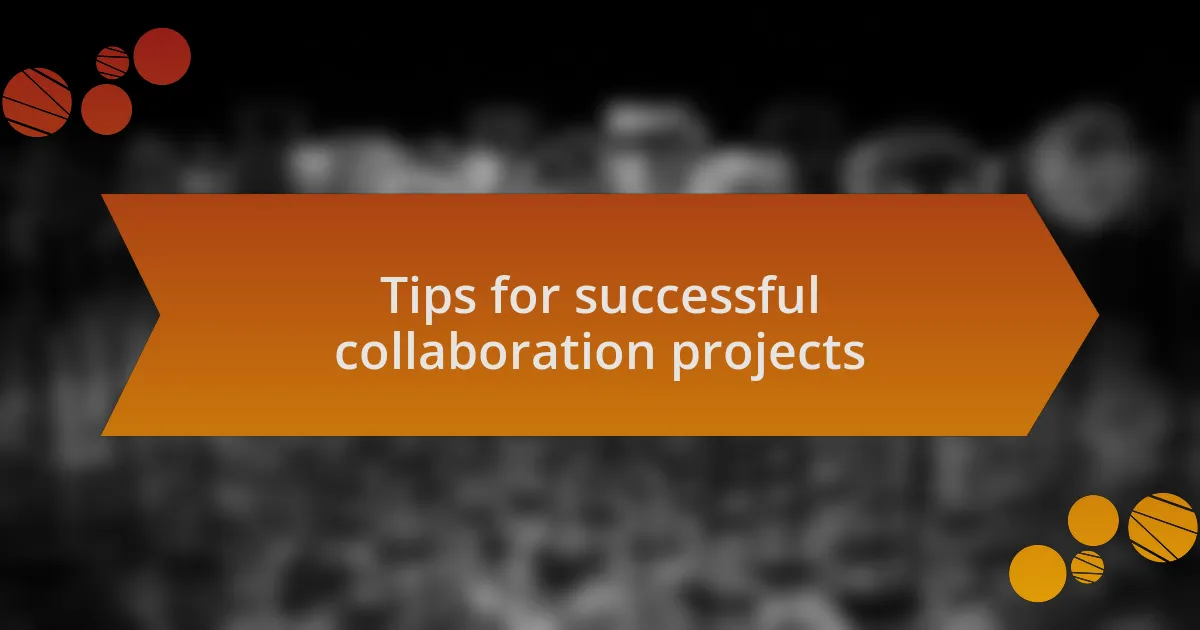
Tips for successful collaboration projects
Collaborating successfully requires clear communication from the outset. I vividly remember a project where my partner and I spent an entire afternoon discussing our visions and expectations. It felt freeing to lay it all out, which ultimately created a roadmap for our artistic journey. Have you ever found that great things emerge from open dialogues?
Setting mutual goals is equally important. I once worked alongside an artist who was more focused on the technical side while I was eager to explore bold narratives. By aligning our objectives early, we managed to blend our strengths seamlessly, turning a potential disconnect into a beautiful fusion of styles. Don’t you think that when both parties share the same destination, the route becomes smoother?
Lastly, flexibility can make or break a project. I recall a time when our original concept needed to change midway through the creative process due to an unexpected constraint. Instead of resisting this shift, we adapted and found that it led us to an even richer outcome than we initially envisioned. How have moments of unexpected change reshaped your collaborative experiences?
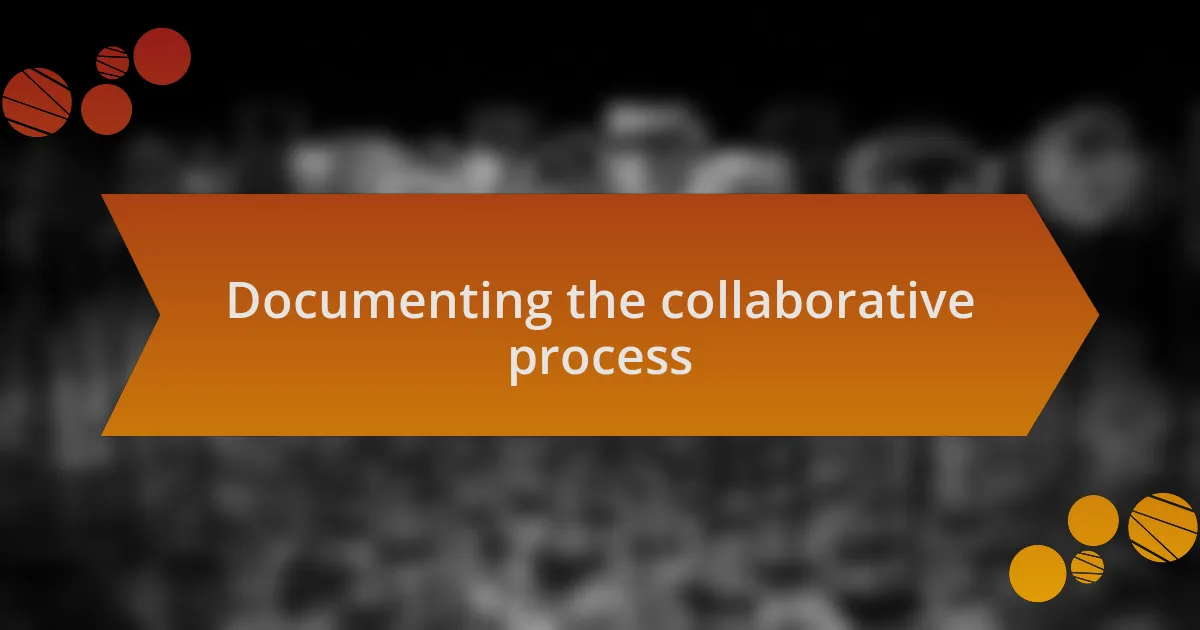
Documenting the collaborative process
Documenting the collaborative process can be both exciting and enlightening. I remember during a project, we decided to keep a visual journal. This journal not only captured our sketches and ideas but also chronicled our conversations and moments of discovery. Looking back, it’s fascinating how it serves as a tangible reminder of our creative evolution. Have you ever thought how these records can reveal the subtleties of your collaboration?
In another collaboration, we utilized photography to document each stage of our artwork. Each photo represented a pivotal moment, from brainstorming sessions to the final touch-ups. It was eye-opening to see how our initial thoughts transformed into a finished piece. This visual progression allowed us to reflect on our journey, reinforcing the idea that every step, no matter how small, contributes to the overall narrative. Doesn’t having that visual timeline enrich the collaborative experience?
Lastly, sharing these documented experiences with our audience felt incredibly rewarding. We created a blog post highlighting our process, sparking conversations with viewers who were keen to learn about the inner workings of our art. It was heartwarming to see how our story inspired others to embark on their collaborative journeys. Have you ever considered how sharing your process can deepen connections with your audience?